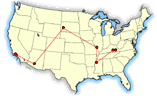AN OVERVIEW OF PRESIDENT CLINTON'S TRIP
TO AMERICA'S NEW MARKETS
Under President Clinton and Vice President Gore, America is Enjoying a Time of Remarkable Economic Expansion. The strength and historic duration of our current economic expansion has helped bring economic opportunity to millions of people once cut off from the economic mainstream. Wages are rising and welfare rolls are shrinking. The economy has created nearly 19 million new jobs since January 1993. Unemployment has dropped from 7.2 % to just 4.3 %. But there is more work to do, particularly in those communities that are economically underserved, such as Appalachia, the Mississippi Delta, inner cities, Native American communities, and others.
President Clinton's Trip will Focus Attention on America's New Markets - Untapped Areas for Potential Investment. From July 5-8, President Clinton will lead a delegation of CEOs, Members of Congress and Cabinet secretaries on an unprecedented trip of untapped markets in the following communities:
- Annville/Hazard, KY -- investment in Appalachia and rural markets
- Clarksdale, MS -- investment in the Mississippi Delta and CDFIs
- East St. Louis, IL -- investment in inner cities and Empowerment Zones
- Pine Ridge Indian Reservation, SD -- investment in Native American communities
- Phoenix, AZ -- access to capital in Hispanic communities and new investment vehicles for low-income communities
- Los Angeles/Anaheim, CA -- private sector workforce investments in disadvantaged youth
These Communities Are in Need of Capital and Investment. This tour will shine a spotlight not only on the needs of these communities, but also on the great potential for growth, profit, and economic opportunity in these untapped markets.
- Appalachia. While Appalachia has seen its poverty rate drop and its per capita income rise since 1993, 32 counties in Appalachia have poverty rates higher than 30%. In addition, the per capita income of the entire Appalachian region is just 71% of the national average. In the Kentucky Highlands Empowerment Zone, 57.3% of people over the age of 25 do not have a high school diploma.
- Mississippi Delta. The poverty rate in the Delta is 20.9%, and 28 counties within the Delta have poverty rates above 30%. Per capita income for the region was $17,003 in 1997, just 67% of the national average.
- Inner Cities. Nearly one-in-three inner cities nationally, or 170 cities total, had poverty rates of 20% or more in 1995.
- Native American Communities. In 1997, half of the Native American workforce remained unemployed, compared to the national rate of 4.9%. Some reservations have unemployment rates much higher, such as 80% for the Cheyenne River Sioux Tribe, and 73% for the Oglala Sioux Tribe in Pine Ridge, South Dakota.
Mobilizing the Private Sector. On this trip, the President will mobilize a large and broad array of private-sector investments in our untapped domestic markets. The following are just a few of the significant new commitments that the private and public sectors are making to America's New Markets:
- First Union, Bank One, BellSouth, Bankers Trust, and others investing in Appalachia.
- New commitments to 14 Community Development Financial Institutions around the country.
- An announcement by a major financial institution about the creation of a new venture capital fund that will be targeted to underserved inner-city markets and that will make available several hundred million dollars in equity capital to small businesses.
- Commitments from dozens of companies to hire thousands of out-of-school youth and disadvantaged young people throughout the nation.
A Record to Build On. President Clinton's effort expands on the innovative approach to community empowerment that he and the Vice President have pioneered for nearly seven years.
- Creating the CDFI Fund. In 1994, President Clinton proposed and signed into law the CDFI Fund which, through grants, loans, and equity investments, is helping to create a network of community development financial institutions in distressed areas across the United States.
- Reforming CRA. In 1995, the Clinton Administration reformed the CRA regulations to emphasize performance. The private sector has pledged more than $1 trillion going forward in loans to distressed communities - and more than 95% of these financial commitments have been made since 1992. (NCRC)
- Creating the Empowerment Zones. President Clinton and Vice President Gore proposed and signed Empowerment Zone legislation in 1993 establishing 105 EZs and ECs across the country. The EZ/EC effort has generated billions of dollars in new private sector investment in community development activities.
- Brownfields and Second Round of EZs. The Administration's Brownfields action agenda has marshaled funds to clean up and redevelop up to 5,000 properties, leveraging billions of dollars in private investment and creating and supporting 196,000 jobs. The President has also signed into law a second round of EZs - 15 new urban and 5 new rural zones.
- Youth Opportunity Initiative and GEAR-UP. In addition to expanding the Earned Income Tax Credit and raising the minimum wage, President Clinton has focused on bringing economic opportunity to young people through the Youth Opportunity initiative and GEAR-UP program. The Youth Opportunity initiative provides skills training leading to job opportunities for out-of-school youth aged 16-24. GEAR-UP helps disadvantaged high-school students prepare for college through mentoring and other forms of assistance.
- Next Steps. Later this month, the President will announce legislation that - through new tax incentives and investment tools -- will make it more attractive for corporate America to search for opportunities in places where they have rarely looked before.
|

